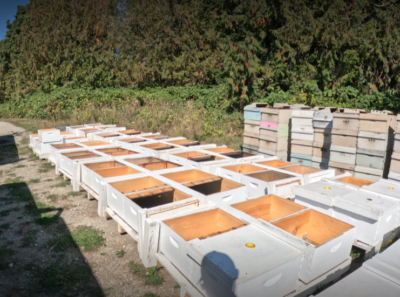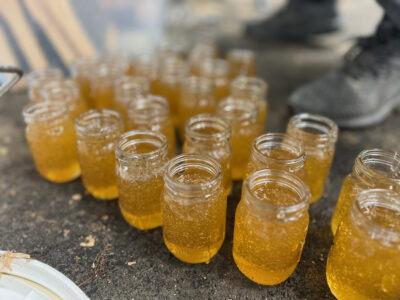Did you know that every year millions of honey bees are brought into California for almond pollination? Commercial bee migration to and from almond fields is a common practice in modern agriculture, especially in regions where almonds are a major crop, such as California. Here is an overview of the process:
1. Pollination Demand: Almond trees are highly dependent on pollination for successful fruit set. Due to the extensive acreage of almond orchards, there is a high demand for honeybee pollination services. Commercial beekeepers transport their hives to almond orchards to meet this demand.
2. Scale of Migration: The scale of bee migration for almond pollination is massive. Hundreds of thousands of honeybee colonies are transported to California’s Central Valley, where a significant portion of the world’s almonds is produced. This migration typically occurs in late winter prior to the almond trees bloom. Beekeepers all over the United States travel their bees to the almond fields.
3. Beekeeper Contracts: Almond growers enter into contracts with commercial beekeepers to secure the necessary number of hives for pollination. The contracts specify the terms, conditions, and the duration of hive placement in the orchards. This is one of the higher paying pollination contracts.
4. Logistics of Transportation: Beekeepers transport their hives on trucks specially designed for bee transport. The hives are secured on pallets and covered with netting to protect the bees during transit. The journey can be long, and the timing is crucial to align with the bloom period.
5. Pollination Period: Almond bloom is a short window, typically a few weeks, during which bees play a crucial role in pollination. The bees collect nectar and pollen from almond blossoms, facilitating cross-pollination and leading to the development of almonds. Almonds are one of the most dependent crops on pollination.
6. Challenges and Risks: Beekeepers face challenges such as exposure to pesticides, weather fluctuations, and potential stress on the bees due to long-distance travel. Almond growers, in turn, depend on the timely and effective pollination of their crops to ensure a successful harvest.
7. Post-Pollination Movement: After almond bloom concludes, beekeepers move their hives to other locations where they are needed for additional pollination services. This could include other fruit and vegetable crops, providing a source of income for beekeepers throughout the growing season. Most beekeepers leave California for other pollination locations.
Commercial bee migration for almond pollination is a symbiotic relationship between beekeepers and almond growers, ensuring the successful cultivation of this economically significant crop. Remember, every time you enjoy an almond it is thanks to the power of the honey bee that you are enjoying almonds!




